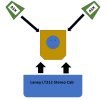Always have wondered this:
not talking about mixing where you need 2 monitors in order to “place” instruments in the stereo field, but for tracking or jamming at home….when running out of FM3 to left and right monitors aren’t you just doubling the signal, seemingly making it unnatural and perhaps muddy……?
sure for deliberate stereo effects such as a stereo chorus or a ping pong delay, it is necessary, but it feels like you lose clarity for a more mono signal with the sound being in two physical locations.
it feels like you get a more traditional guitar playing experience from listening/tracking through just one studio monitor, dare I say more “amp in the room”.
how do you guys address this at home? I hope I am making sense. Hoping you will share some thoughts if I’ve explained myself well.
not talking about mixing where you need 2 monitors in order to “place” instruments in the stereo field, but for tracking or jamming at home….when running out of FM3 to left and right monitors aren’t you just doubling the signal, seemingly making it unnatural and perhaps muddy……?
sure for deliberate stereo effects such as a stereo chorus or a ping pong delay, it is necessary, but it feels like you lose clarity for a more mono signal with the sound being in two physical locations.
it feels like you get a more traditional guitar playing experience from listening/tracking through just one studio monitor, dare I say more “amp in the room”.
how do you guys address this at home? I hope I am making sense. Hoping you will share some thoughts if I’ve explained myself well.

 through multiple speakers. It just sounds “bigger” to me.
through multiple speakers. It just sounds “bigger” to me.